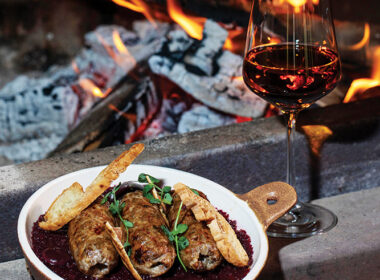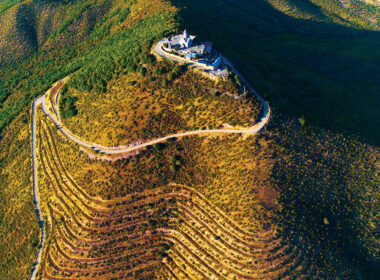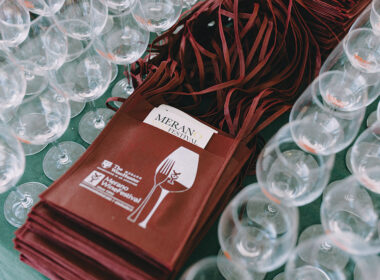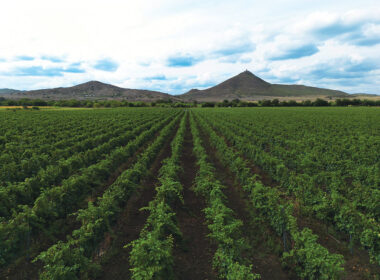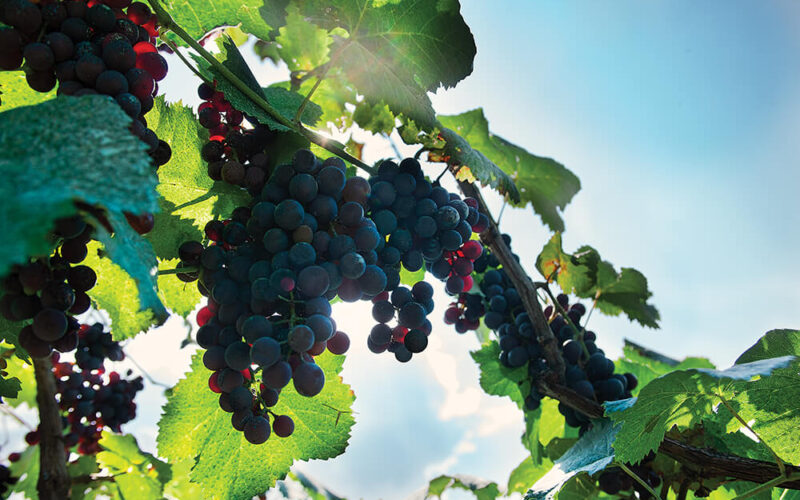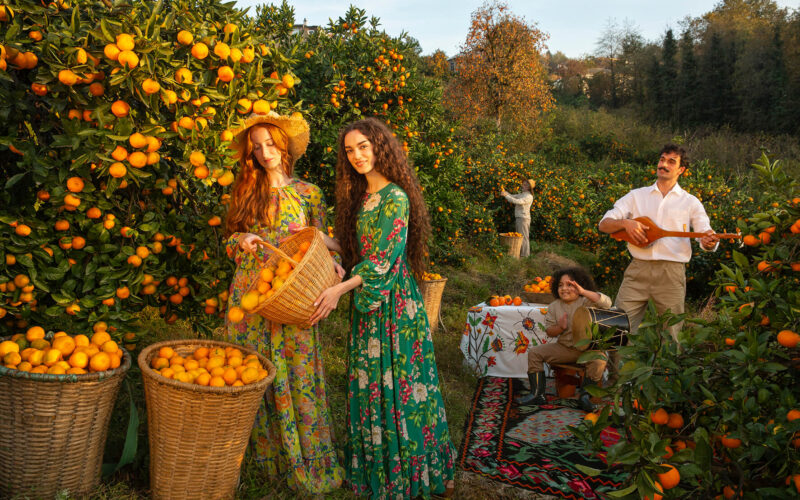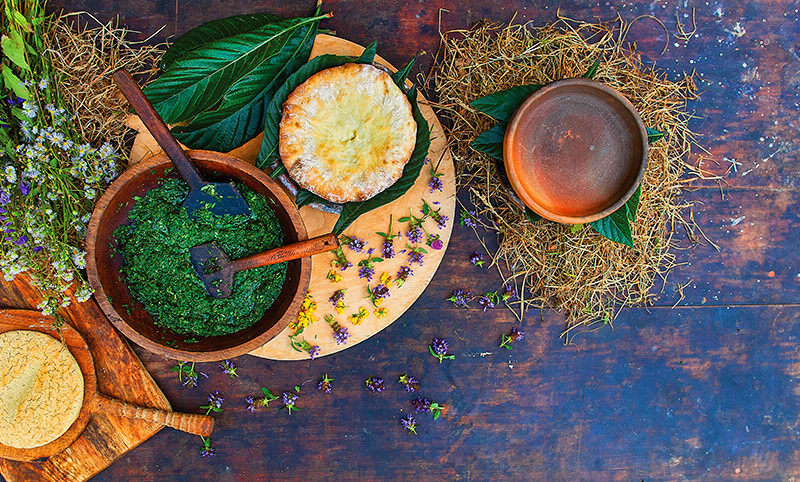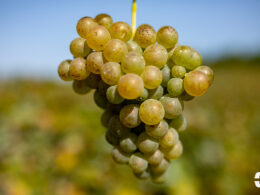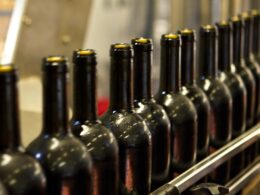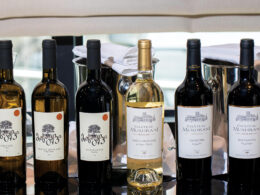Giorgi Samanishvili
“Khvanchkara” wine
Red, naturally semi-sweet wine from Racha. Dark ruby, soft, aromatic, with a distinct scent of red fruit and berries, and a flower aromas of rose.
Khvanchkara micro zone
Racha – municipality of Ambrolauri, 450-750 metres above sea level. The micro zone includes nearby villages: Tsesi, Kvatskhuti, Sadmeli, Ghviara, Bostana, Didi Chordjo, Patara Chordjo, Meore Tola, Pirveli Tola, Chrebalo, Chkvishi, Zhoshkha, Kvishari, Ghvardia, Bareuli, Ghadishi, Badji, Bugeuli, Saketsia, Jvarisa, Itsa, Krikhi, Akhalsopeli, Gori, Khimshi, Abanoeti.
Grape varieties: Aleksandrouli and Mujuretuli
Grape yield per hectare: no more than 7000 kg
Wine yield per hectare: no more than 4550 litres
Chemical characteristics of wine: Alcohol – no less than 11%. Sugar content – 30-45 g/l. Acidity – no less than 5 g/l. Our journey of Georgian vineyards starts with an extraordinary region of Racha.
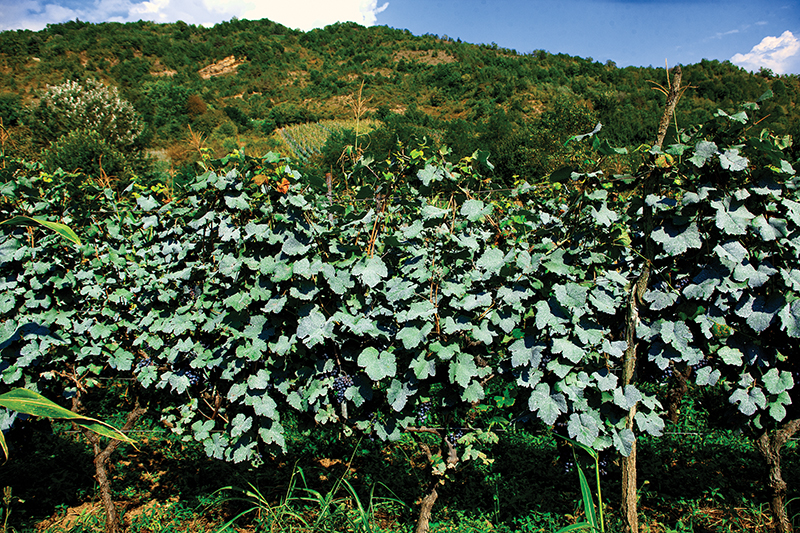
Vineyards in Racha
Hemmed by the Greater Caucasus Mountains, Racha is located between Racha and Lechkhumi Ridges, in the Valley of Riori River. It is famous for its exceptional beauty and wonderful wine. Here, vineyards spread on both sides of Rioni River, but occupy only about 800 hectares (for comparison, vineyards in Kakheti region occupy around 30 000 hectares). The most prominent grape varieties of Racha – Aleksandrouli and Mujuretuli – make up only 1/3 of the total amount.
Despite the small amount of vineyards, Racha is as popular for its wine as any other region in Georgia. In fact, local wines have always been high in demand, and you can certainly notice it during the harvest: around October, after all the grape is collected in Kakheti, people head to Racha, and the region gets very busy with wine professionals and wine lovers.
Historically, there were much more vineyards in Racha than there are today. Sources indicate that at the end of the 19th century their area was around 3000 desyatinas (a measuring unit used before the metric system), which is a bit more than 3000 hectares. Some sources suggest this number to be closer to 5000 hectares. According to later sources, the total area of vineyards in Racha by the 1950s was 3200 hectares, which made wine making a rather lucrative affair for locals.
Past numbers can only mean one thing: there is a potential for more vineyards in Racha, which would greatly contribute to its economic growth and well-being.
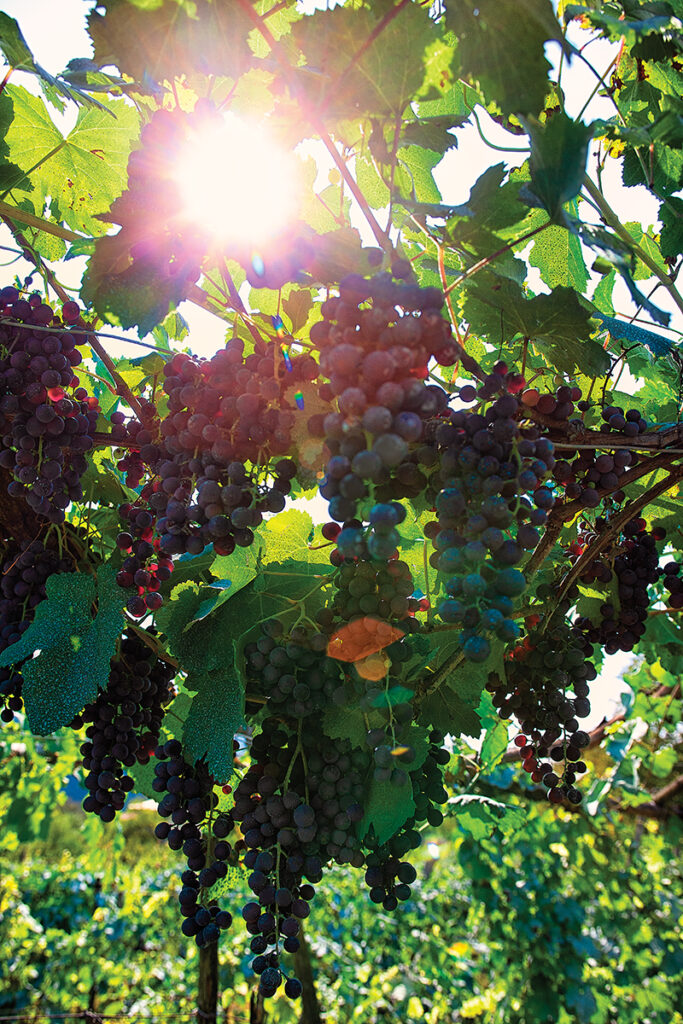
Micro zones of Racha, its soil and climate
Racha is divided into two municipalities of Oni and Ambrolauri, or, when it comes to wine making, simply Upper and Lower Racha. Upper Racha or Oni district, is in a mountainous zone and wine making gives way to other agricultural activities, such as livestock farming.
Most vineyards are located lower, stretching from Oni to Ambrolauri district, and this is exactly where the potential lives when it comes to wine making and tourism. To this day, Khvanchkara is the most famous wine made from local grapes, however other varieties make for no less a wine than their famous counterparts. There are endemic varieties here that are worth mentioning, they produce light bodied and truly unique tasting wines.
Vineyards in Lower Racha spread through both banks of Rioni River, 450-800 metres above sea level. Historically, the right bank is called Khvanchkara micro district, and left is known as Ambrolauri-Bugeuli micro district. Wines taste different depending on which side was the grape grown on.
Vineyards on the right bank fall on the southern side; they get sunlight throughout the day. Villages on this side, such as: Tola, Khvanchkara, Chorjo, Bostana, were historically known for their grape varieties. This is the land where local grapes Aleksandrouli and Mujuretuli grow, and this is home to Khvanchkara or Kipianis’ wine.
Consequently, vineyards on the left bank of the river are on the northern side. Grapes here get less sunlight, but the temperature still remains high, so the grapes mature just as easily. This side (so-called Bugeuli micro district) is said to be better for white grape and Shavi (Black) Kapistoni growth. There are also some Aleksandrouli and Mujuretuli vines here.
As we ascend through villages, the number of vineyards decline, since it gets harder for grapes to reach their maturity.
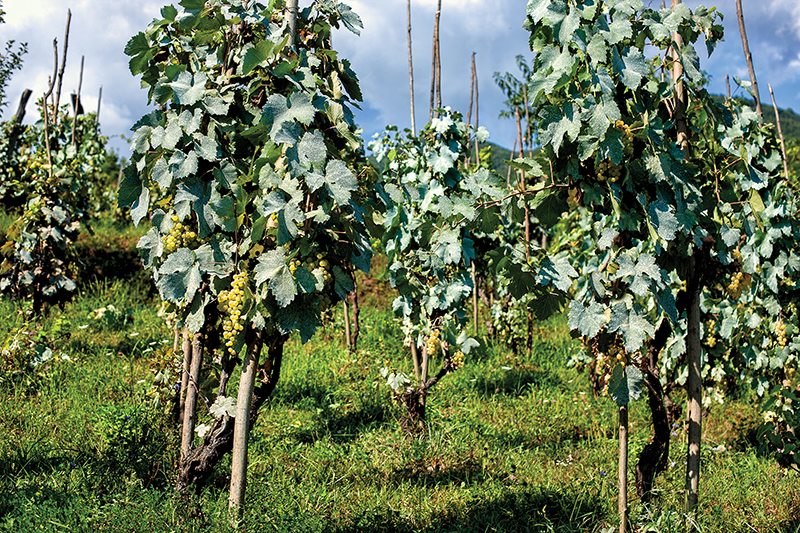
In terms of soil, Lower Racha has mainly humus-carbonate and clay soils as well as limy soil, flint mixed with clay and sand with clay, which are ideal for quaility wines. Climate is quite humid, but Rioni “ventilates” the area, so the chances of finding high humidity related diseases are low. High ranges of Racha and Lechkhumi protect the valleys from excess wind and dramatic weather changes. The area gets lots of sunlight and warmth. All of this lets the grape take its time to mature and yield rich, complex and verstaile wine.
Grape varieties in Racha
The most prominent from red grape varieties in Racha are Aleksandrouli and Mujuretuli, while Rachuli (or Tsulukidze) Tetra is the most famous in white grapes.
Endemic varieties of Aleksandrouli and Mujuretuli are quite similar. Some say that they have the same ancestry, namely a grape called “Old Aleksandrouli”, which spawned Aleksandrouli and Mujuretuli. A similarity between these two varieties can be found in their twigs, leaves and cordons, but their berries are vastly different. Aleksandrouli berry is round, while Mujuretuli berry is elongated. Mujuretuli reaches its maturity a little bit earlier. While mature, the skin gets quite firm and pops nicely in the mouth. These two varieties were traditionally grown together in mixed vineyards. It is only for the last 10-15 years, winemakers have started to grow them independently.
Other red grapes in Racha include Imeretian Dzelshava, which yields a unique wine – simpler, but with an interesting, attractive aroma. Locals often refer to this variety as Dzvelshava.
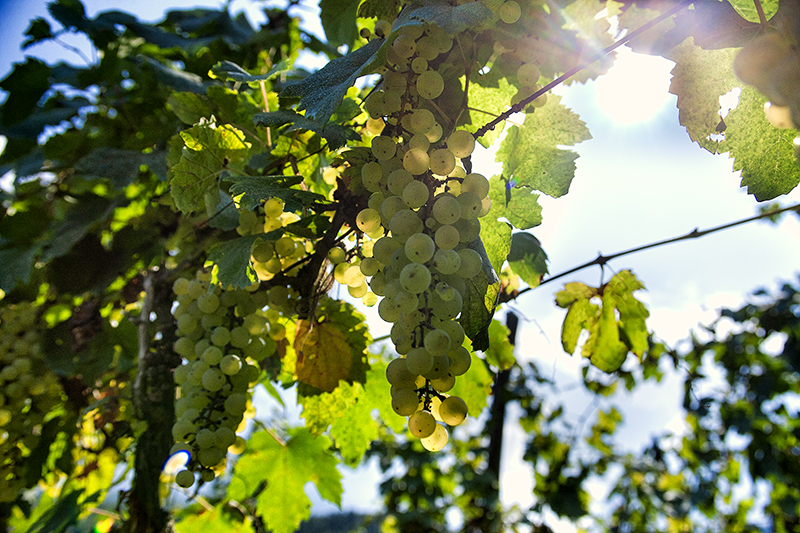
Kakhetian Saperavi is also quite widespread here. It was brought to this region in the beginning of the 20th century to mix in with Khvanchkara. Saperavi grown in Racha, yields a dark aromatic wine, which is softer and milder than traditional Saperavi. Another Imeretian variety found here is Otskhanuri Sapere. Some endemic varieties include – Shavi (Black) Kabistoni, Arabeuli and Rtskhili (or Rtskhila). They are historically known as the most widespread varieties for this region.
As mentioned above, the most famous white grape variety here is Rachuli or Tsulukidze Tetra – a source of pride for locals. Demand on this variety is so high that it rarely gets bottled. The privilege of tasting it is awarded to locals or their very lucky guests.
Some other white grapes here include: Imeretian Tsolikouri, Goruli Mtsvane (known here as Kvishkhura), Gorula, Tsitska and other grapes, either local or brought from neighboring regions.
Wines of Racha
Khvanchkara – despite its scarcity, it is the most well-known wine of Racha, produced in PDO (Protected Designation of Origin). It is made through non-complete fermentation of ripe Aleksandrouli and Mujuretuli grape varieties. Grape makes up for at least 23%, with sugar content of 25-27%. Grapes are pressed, rid of stalks and left for alcoholic fermentation for about 4-5 days. Before the malolactic fermentation starts, the skins and pips are removed, and the liquid is left in cold temperatures. This helps preserve the natural sweetness at around 40 g/l.
Once, a wine called Barakoni was very popular in this region. Even though it was semi-dry, it was known as “Khvanchkara-like”. Today, it is hardly ever made.
Dzelshavi – light red, aromatic, simple wine, mainly produced in family wineries.
Rachuli Tetra – famous wine from Racha, made by traditional recipes of the region. After the grapes are pressed, must, pips, stalks and skins are all put together and left for a couple of days (this can even start the alcoholic fermentation). Later, “chacha” (pips, stalks and skins) is removed and the juice is left to ferment on its own. This results in a mild, but very aromatic wine, which can be a bit on a sweeter side, but is mostly dry, with a unique color.
Tsolikouri – this is considered an everyday wine in most of the Western Georgia. It can be found in every household. There are several methods of making this wine: European or Classic and Imeretian. If it is made with Imeretian method, the “chacha” is added to the must, so it ferments better and gets more body.
Khimshuri – a once popular wine in Racha made from Rtskhili grape variety. Khimshi village is on the way from Oni to Ambrolauri, near Tsesi village. Khimshuri was always well acclaimed by locals and travelers alike. Sadly, it is rarely produced today.
Kipianis’ Wine and history of Khvanchkara
Khvanchkara is infinitely connected to a noble name of Kipiani. Sources indicate that Kipiani family made exceptionally good wine in Racha since 19th century. They would sell their wine in the region as well as Kutaisi (the price was quite high – a bucket for 2 roubles), gradually importing it to the Russian Empire. Prior to World War I, Kipianis were very successful in making wine.
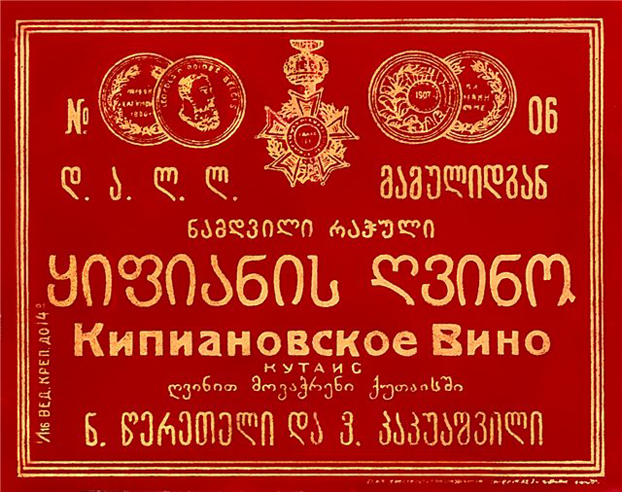
In 1890, Kipiani wines were deemed best in Kutaisi gubernia (an administrative subdivision in the Russian Empire). In 1900, they got a prize and a medal titled “Sanakebo” (“Well-acclaimed” in Georgian) on the first Agricultural Exhibition in Batumi. In 1907, Kipiani wine won a grand-prix in Ostend, Belgium. They were given a diploma, a medal and a special token with the image of king of Belgium to commemorate this event (this token is now kept in the Georgian National Museum).
One of the labels of Kipiani wine bottles said – “Authentic Kipiani Wine from Racha – from the lands of Dimitri, the son of Aleksandre and Luarsab, the son of Luarsab, sold by “Wine Merchants of Kutaisi” – Nestor Tsereteli and Varlam Papuashvili”. Counterfeiting wine was not an uncommon thing even back then and stating the names of merchants was one of the proofs of its authenticity.
1920 saw the first mass-production of Khvanchkara by “Khvanchkara Wine Cellar Cooperation”. It was made with a traditional method of pressing only mature Aleksandrouli and Mujuretuli grapes and using a non-complete fermentation. From this point on, Kipiani Wine was renamed to “Khvanchkara”. “Khvanchara Wine Cellar Cooperation” was first a part of Vine and Wine Union “Georgian Wine” and later in 1932, became a part of Public Agricultural Trust “Samtresti”.
In 1930-40s, the government took a more active role in development of Khvanchkara. Professor Konstantine Modebadze studied the wine meticulously and refined its production methods. During these years, several wine cellars were built and renewed in Racha (In villages Khvanchkara, Chrebalo and city of Ambrolauri). All of these cellars became part of “Samtresti” from 1942 and focused entirely on Khvanchkara production.
Despite rebranding, Kipiani Wine (now, Khvanchkara) quickly regained popularity due to its quality. Following Khvanchkara’s success, other naturally sweet wines were emerging: Kindzmarauli, Akhasheni, Ojaleshi, Usakhelauri that became very popular in Soviet Union after World War II.
In the beginning of 2000s, when Georgian wine export and production revived, demand of Khvanchkara started to grow. Before the Protected Designations of Origin regulations were enacted, there was a serious threat to all Georgian wines and Khvanchkara in particular – they were produced and sold illegally throughout Georgia and abroad.
In 2002, the name was protected under president’s decree. In 2007, National Intellectual Property Center of Georgia registered specifics of Khvanchkara production and various control mechanisms were enabled to fight against wine falsification. A number of cases defending the name “Khvanchkara” were filed in courts abroad. All of them ended in favor of Georgia.
In the last years, harvest in Racha undergoes a strict control. Grape processing is rigorously accounted. Wine is successfully sold in Georgia and exported abroad. Aleksandrouli and Mujuretuli have the highest prices on the market, therefore Khvanchkara is one of the most expensive wines in Georgia.

Khvanchkara – new challenges
As I’ve mentioned above, Khvanchkara is successfully sold in Georgia and abroad. It already has stable buyers in local markets, ready to pay the high price.
Today, Georgian wine is actively conquering new markets. Its awareness is growing; new customers are positively receiving our traditional wines – qvevri wines, amber wines and others. However, Khvanchkara (and other naturally semi-sweet wines) are mainly consumed locally or sold on traditional markets. New market demand on these wines remains low. Companies or wine cellars selling Khvanchkara do not own any vineyards or cellars in Racha. Instead, they buy the grape and use to produce Khvanchkara along with many other varieties of wine. Since the price on grape is high, and its maintenance is quite hard, wine producers rarely promote Khvanchkara in new markets, they prefer to concentrate their energies on wines with high demand. Khvanchkara is mainly left to its divices, which is a sad thing to admit since it has a great potential due to its history, taste and style. It can easily stand its ground among prestigious wines, but this requires a lot of effort and resources.
The first challenge is managing grape outflow from Racha. There are a number of benefits to producing the wine in its place of origin:
- More jobs will be created, not solely in vineyards but in wine cellars as well; this will help increase the knowledge and experience of local winemakers;
- Local winemakers will get more involved in the sales process;
- More tourists will flow to Racha, since Khvanchkara can become a sort of locomotive for attracting tourists to the region. Increased interest in Khvanchkara will stimulate smaller wine cellars and tasting halls to emerge, along with other necessary infrastructure;
- Increase in local wine production will result in other wines of Racha, such as dry Aleksandrouli, Shavi (Black) Kapistoni, Dzelshavi or Tetra, to be produced as well. This variety of wines will attract more visitors, which means more revenue for Khvanchkara producers;
- If locals also sell wine (not just grape), more attention will be paid to quality of grape, instead of quantity;
- No one knows local wines better than people of Racha and if wine production takes place here, they will be avid advocates for it, showcasing their product in the best possible way.
Comparing to other regions, Racha has a massive advantage: its size and geographical location. Out of 10 wine making regions in Georgia, it is the smallest and naturally boarded region. Even in the best-case scenario, the total amount of potential vineyards will never exceed 3 or 4 thousand hectares. If all the necessary resources and effort are well invested, limited quantity and good quality of a product will automatically call for a high price. High quality, limited quantity and high prices have always been the marketing strategy for Georgia.
Another important aspect is refining the style of Khvanchkara wine. A high quality Khvanchkara is made from overly ripe grapes. When ripe grape fermentation is interrupted, you get a naturally semi-sweet wine. If fermentation goes on, wine will have more alcohol, but will be less sweet. If the fermentation completes, we will get a dry wine high in alcohol. However, when grape is overripe, all of this changes. You get more character, more aromas, strength and pleasantness.
Experimenting with the process could lead to interesting discoveries: it’s possible that dry or semi-dry Khvanchkara is rather exciting. Some necessary precautions in this case would be to:
- Ensure the maturity (ripeness) standard is controlled. Otherwise, we might get an empty, meaningless wine;
- Labels on the bottle should clearly indicate the style of wine: semi-sweet or dry.
Italy’s Valpolicella Recioto and Amarena can be used as good references for these cases.
Changin type and style of Khvanchkara is such an important matter, that it should only be decided and executed by winemakers of Racha. It would be beneficial to create an associated of Khvanchkara. Local winemakers, viticulturists and public should unite for a common cause – development of Khvanchkara wine. It should be local professionals who make strategic decisions and plan marketing activities for new and traditional markets. After all, it is only the locals who make an exceptional and exclusive Khvanchkara, and they are the ones who can explain its uniqueness to consumers, making it more popular and trendy.
Naturally semi-sweet wines
We see a decline in popularity of semi-sweet and sweet wines in the world today. They are commonly associated with cheaper, artificially sweetened wines, which are considered to be for amateur consumers. This is less of a case with famous wines from Protected Designations of Origin, such as Hungarian Tokaji Aszú, Italian Recioto della Valpolicella, French Sauternes, German BA, TBA and Eiswein, fortified Porto, Sherry and etc. However, their producers still put a lot of effort in maintening their popularity.
Most of the above-mentioned wines are white. Winemakers and viticulturists have to keep a close eye on the balance of sugar content, acidity and sweetness in case of white whines. In case of red wines, a fourth component – tannin level – comes into play. It is difficult for a novice to appreciate a red, sweet wine; it is infinitely harder for an untrained professional to make it. It requires a lot of experience.
In his works, Konstantine Modebadze notes that when the grape is at the right maturity, sugar content in Aleksandrouli (and Mujuretuli) grape in Khvanchkara district was as high as 27-30%. The fermentation stopped automatically at an alcohol level of 12-14%, with sweetness at 50-60 g/l. In the same district, Aleksandrouli (and Mujuretuli) kept a high acitidy (more than 5 g/l), even when overripe, which balanced out high alcohol and sweetness.
Tannins are also ripe in a mature grape, which gives a strong taste to wine, as opposed to astringent. Kipiani family was the first one to create an initial balance of alcohol, sweetness, acidity and tannins, which was later refined by other winemakers and researchers.
Another interesting fact about Khvanchkara is its color. Today it varies from light to dark ruby, however in older sources we find that this wine was exclusively described as dark ruby. The skin of a well-matured grape gives more coloring particles making the wine darker.
Adhering to standards of maturity and production of Khvanchkara will yield a darker, more aromatic, soft and balanced Khvanchkara wine.
Inclusion
Valpolicella is a viticultural zone in Veneto region of Italy, famous for its naturally sweet red wine Recioto Della Valpolicella, made from Corvina and other varieties.
To increase their natural sugar levels, the grapes are first dried after harvest and then pressed. After a non-complete fermentation of dregs, we get a famous naturally semi-sweet Recioto, with alcohol content no less than 12%, and sugar content no less than 50 g/l.
In 1950, local winemakers started making dry wine from grapes used for Recioto. They made it without decreasing the initial sugar levels of grape. What they got was a high-alcohol wine (14% according to specifications, but 15% and more in practice), with strong aroma and taste. They called it Amarone (Amaro means bitter in italian).
As a result, today, red, high-alcohol, dry wine Amarone is more popular than its predecessor – red, sweet Recioto.

